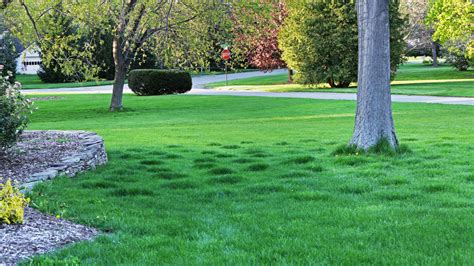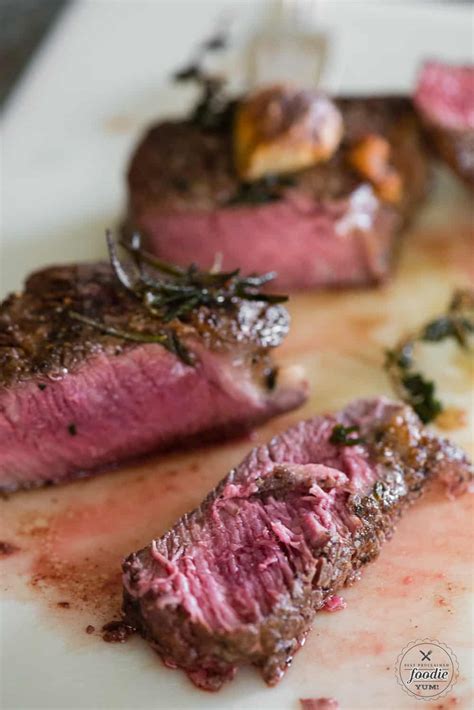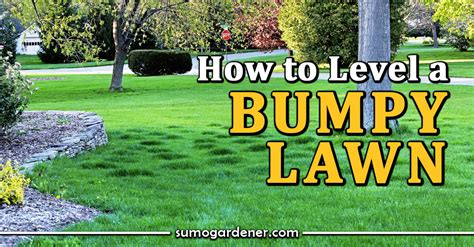
Leveling a bumpy lawn can be achieved affordably and without strenuous labor by using readily available materials and a simple technique known as topdressing. This method, detailed in a recent report, allows homeowners to smooth out uneven surfaces, improve drainage, and enhance the overall health of their lawns without the need for expensive equipment or professional landscaping services.
Affordable Lawn Leveling: A DIY Guide to a Smooth, Healthy Yard
Bumpy lawns can be an eyesore and a tripping hazard, but achieving a smooth, even surface doesn’t have to break the bank or your back. A straightforward and cost-effective solution lies in the practice of topdressing, a method involving the application of a thin layer of material to fill in low spots and create a level playing field for your grass.
Topdressing offers several benefits beyond aesthetics. It improves drainage, reduces soil compaction, and promotes a healthier root system, ultimately leading to a more resilient and vibrant lawn. Unlike more invasive methods like tilling and re-sodding, topdressing is a gentle approach that minimizes disruption to existing grass and soil structure.
The Topdressing Technique: A Step-by-Step Approach
The key to successful topdressing lies in the preparation and application of the leveling mix. According to lawn care experts, the ideal mixture consists of equal parts of the existing topsoil, sand, and compost. This blend provides a balance of drainage, aeration, and nutrients, creating an optimal environment for grass growth.
Before applying the leveling mix, it’s essential to identify and mark the low spots in your lawn. This can be done by simply walking around your yard and noting areas where water tends to pool or where the ground feels noticeably uneven underfoot. Once the low spots are identified, you can begin the topdressing process.
The first step involves mowing your lawn to a relatively low height, typically around 1 to 1.5 inches. This allows the leveling mix to make direct contact with the soil and encourages the grass blades to grow through the new layer. After mowing, use a rake to loosen any compacted soil in the low spots and remove any dead grass or debris.
Next, apply the leveling mix to the low spots, using a shovel or wheelbarrow to transport the material and a rake to spread it evenly. The goal is to fill in the low spots without completely burying the existing grass. “You want to aim for no more than half an inch of material in each area,” advises a lawn care specialist. “If you completely cover the grass, it will struggle to grow through the new layer.”
After applying the leveling mix, use the back of a rake or a stiff brush to work the material into the surrounding grass. This helps to blend the new layer with the existing lawn and ensures that the grass blades are not suffocated. Repeat this process as needed, adding more leveling mix to the low spots until they are level with the surrounding ground.
Once the topdressing is complete, water the lawn thoroughly to help the leveling mix settle and to promote root growth. Avoid heavy watering, which can wash away the material and undo your hard work. Instead, opt for light, frequent watering, especially during dry periods.
Choosing the Right Materials: Soil, Sand, and Compost
The success of topdressing hinges on the quality of the materials used. Selecting the right soil, sand, and compost is crucial for creating a leveling mix that is both effective and beneficial to your lawn.
The topsoil component of the leveling mix should ideally be sourced from your own yard. This ensures that the new layer is compatible with the existing soil structure and minimizes the risk of introducing foreign contaminants. If you need to purchase topsoil, choose a high-quality product that is free of rocks, weeds, and other debris.
The sand component should be a coarse, gritty variety, such as builder’s sand or horticultural sand. Avoid using fine sand, such as play sand, as it can compact easily and impede drainage. The sand helps to improve drainage and aeration, preventing the leveling mix from becoming waterlogged.
The compost component should be a well-decomposed organic matter, such as composted leaves, grass clippings, or manure. Compost provides essential nutrients to the grass and helps to improve soil structure. Choose a compost that is free of weed seeds and other contaminants.
Timing is Key: When to Topdress Your Lawn
The best time to topdress your lawn is during the active growing season, typically in the spring or early fall. During these periods, the grass is actively growing and can quickly recover from the topdressing process. Avoid topdressing during the heat of summer or the cold of winter, as the grass may be dormant and less able to recover.
In the spring, topdressing can help to repair any damage caused by winter weather and prepare the lawn for the growing season ahead. In the fall, topdressing can help to improve soil health and protect the grass from the harsh conditions of winter.
Addressing Common Concerns: Weeds, Thatch, and Drainage
While topdressing is a relatively simple and effective method for leveling a bumpy lawn, there are a few common concerns that homeowners should be aware of.
One concern is the potential for introducing weeds into the lawn. To minimize this risk, use high-quality topsoil, sand, and compost that are free of weed seeds. You can also apply a pre-emergent herbicide to the lawn before topdressing to prevent weed seeds from germinating.
Another concern is the buildup of thatch, a layer of dead organic matter that can accumulate on the surface of the soil. Thatch can impede drainage and prevent nutrients from reaching the roots of the grass. To prevent thatch buildup, aerate the lawn regularly and avoid over-fertilizing.
Poor drainage can also be a problem, especially in areas with heavy clay soil. To improve drainage, incorporate plenty of sand into the leveling mix and consider installing a drainage system to remove excess water from the lawn.
Beyond Topdressing: Other Lawn Leveling Options
While topdressing is an affordable and effective method for leveling minor bumps and dips in your lawn, it may not be sufficient for addressing more severe unevenness. In such cases, other lawn leveling options may be necessary.
One option is to till the lawn and re-grade the soil. This involves using a tiller to break up the existing soil and then using a rake or shovel to redistribute the soil and create a level surface. This method is more labor-intensive than topdressing, but it can be effective for addressing significant unevenness.
Another option is to remove the existing sod and re-grade the soil. This involves using a sod cutter to remove the existing grass and then using a rake or shovel to redistribute the soil and create a level surface. Once the soil is level, new sod can be laid. This method is more expensive than topdressing or tilling, but it can provide a quick and effective solution for leveling a severely uneven lawn.
Maintaining a Level Lawn: Ongoing Care and Prevention
Once you’ve leveled your lawn, it’s important to take steps to maintain its even surface and prevent future bumps and dips from forming.
Regular mowing is essential for maintaining a healthy and level lawn. Mow the grass at the correct height for your grass type and avoid scalping the lawn, which can weaken the grass and make it more susceptible to damage.
Proper watering is also crucial for maintaining a level lawn. Water the lawn deeply and infrequently, rather than shallowly and frequently. This encourages the grass roots to grow deep into the soil, making the lawn more resistant to drought and unevenness.
Fertilizing the lawn regularly can also help to maintain its level surface. Use a fertilizer that is specifically formulated for your grass type and follow the instructions on the label. Avoid over-fertilizing, which can lead to thatch buildup and other problems.
Finally, be sure to address any drainage issues promptly. If water tends to pool in certain areas of your lawn, take steps to improve drainage, such as installing a drainage system or amending the soil with sand or compost.
The Long-Term Benefits of a Level Lawn
Investing the time and effort to level your lawn can provide numerous long-term benefits, both aesthetic and practical.
A level lawn is more visually appealing than a bumpy lawn. It creates a smooth, uniform surface that enhances the overall appearance of your property. A level lawn is also safer to walk on, reducing the risk of trips and falls. This is especially important for families with young children or elderly individuals.
A level lawn is also easier to maintain. Mowing, watering, and fertilizing are all easier and more efficient on a level surface. A level lawn also promotes healthier grass growth by allowing for better drainage and aeration.
Conclusion: Achieving a Smooth Lawn is Within Reach
Leveling a bumpy lawn doesn’t have to be a daunting or expensive task. By following the simple steps outlined above and using readily available materials, you can achieve a smooth, even surface that enhances the beauty and functionality of your outdoor space. Whether you choose to topdress, till, or re-sod, the key is to take the time to do the job properly and to maintain your lawn with ongoing care and prevention. With a little effort, you can transform your bumpy lawn into a lush, level oasis that you can enjoy for years to come. “With the right technique and materials, anyone can achieve a level lawn without breaking the bank or their back,” concludes the lawn care specialist.
FAQ: Leveling Your Bumpy Lawn
-
What is topdressing, and how does it help level a bumpy lawn?
Topdressing is the process of applying a thin layer of material, typically a mixture of topsoil, sand, and compost, to the surface of a lawn to fill in low spots and create a more even surface. It improves drainage, reduces soil compaction, and promotes healthier root growth, ultimately leading to a smoother and more resilient lawn. “You want to aim for no more than half an inch of material in each area,” advises a lawn care specialist.
-
What materials are needed for topdressing, and how do I choose the right ones?
The ideal topdressing mixture consists of equal parts topsoil, sand, and compost. The topsoil should be high-quality and free of debris; ideally, sourced from your yard. Use coarse, gritty sand like builder’s or horticultural sand, avoiding fine sand. The compost should be well-decomposed organic matter, such as composted leaves or manure, free of weed seeds.
-
When is the best time of year to topdress my lawn for optimal results?
The best time to topdress is during the active growing season, typically in the spring or early fall. During these periods, the grass is actively growing and can recover quickly. Avoid topdressing during the heat of summer or the cold of winter.
-
How do I prevent weeds from growing after topdressing my lawn?
To minimize the risk of weeds, use high-quality topsoil, sand, and compost free of weed seeds. Consider applying a pre-emergent herbicide before topdressing to prevent weed seeds from germinating.
-
What are the alternatives to topdressing for leveling a very bumpy lawn, and when should I consider them?
For severely uneven lawns, alternatives include tilling the lawn and re-grading the soil, or removing the existing sod and re-grading before laying new sod. Consider these options when topdressing is insufficient to address significant unevenness. Tilling and re-grading involves breaking up the existing soil and redistributing it. Removing and relaying sod involves removing the existing grass, leveling the soil, and then installing new sod. These methods are more labor-intensive or expensive but are more effective for severe cases.
Extended Analysis and Additional Considerations
The method described provides an accessible entry point for homeowners to address minor imperfections in their lawns without resorting to expensive landscaping services. However, the success of topdressing, and the suitability of the method itself, depends on a range of factors, including the severity of the lawn’s unevenness, the type of soil, the prevailing climate, and the overall health of the existing grass.
Detailed Breakdown of Topdressing Materials:
- Topsoil: While using topsoil from your yard is ideal to ensure compatibility, this isn’t always feasible. When purchasing topsoil, carefully inspect it. Look for a dark, rich color, a loose and crumbly texture, and a slightly earthy smell. Avoid topsoil that is pale, compacted, or has a foul odor. Screen the topsoil to remove any large rocks, roots, or debris before mixing it with the other components.
- Sand: The type of sand is critical. Coarse sand particles create air pockets in the soil, improving drainage and preventing compaction. Fine sand, like play sand, can actually worsen drainage problems. Builder’s sand is readily available at most home improvement stores and is a suitable choice. Horticultural sand, specifically designed for gardening applications, is another excellent option but may be more expensive.
- Compost: Compost is more than just a filler; it’s a vital source of nutrients and beneficial microorganisms that improve soil health and promote grass growth. Choose a compost that is well-decomposed and has a dark, earthy appearance. Avoid compost that is still raw or has a strong ammonia smell. Composted manure, leaves, and grass clippings are all excellent choices. You can also make your own compost at home using kitchen scraps and yard waste.
Addressing Specific Lawn Types and Soil Conditions:
- Clay Soil: Lawns with heavy clay soil are prone to compaction and poor drainage. When topdressing clay soil, increase the proportion of sand in the leveling mix to improve drainage. Consider aerating the lawn before topdressing to further alleviate compaction.
- Sandy Soil: Sandy soil drains quickly but doesn’t retain moisture or nutrients well. When topdressing sandy soil, increase the proportion of compost in the leveling mix to improve water retention and nutrient availability.
- Specific Grass Types: Different grass types have different needs. Warm-season grasses like Bermuda and Zoysia are more tolerant of topdressing than cool-season grasses like fescue and Kentucky bluegrass. Adjust the timing and frequency of topdressing to suit the specific needs of your grass type. Consult with a local lawn care expert for recommendations.
Beyond Aesthetics: The Environmental Benefits of a Healthy Lawn:
A healthy, level lawn provides numerous environmental benefits, including:
- Erosion Control: A dense lawn helps to prevent soil erosion by anchoring the soil in place and reducing runoff.
- Water Filtration: Lawns act as natural filters, removing pollutants from rainwater before it enters groundwater supplies.
- Carbon Sequestration: Grass absorbs carbon dioxide from the atmosphere and stores it in the soil, helping to mitigate climate change.
- Oxygen Production: Lawns produce oxygen, which is essential for human and animal life.
Potential Pitfalls and Troubleshooting:
- Uneven Application: Applying the leveling mix unevenly can create new bumps and dips in the lawn. Take your time and use a rake to spread the material evenly.
- Complete Coverage: Completely burying the grass with the leveling mix can suffocate the grass and prevent it from growing. Aim to leave the tips of the grass blades exposed.
- Weed Infestation: Using contaminated topsoil, sand, or compost can introduce weeds into the lawn. Be sure to use high-quality materials and consider applying a pre-emergent herbicide.
- Thatch Buildup: Over-topdressing can contribute to thatch buildup. Aerate the lawn regularly to prevent thatch from accumulating.
- Poor Drainage: If the leveling mix doesn’t drain properly, it can create a soggy mess. Ensure that the leveling mix contains enough sand to improve drainage.
Advanced Techniques and Professional Assistance:
For homeowners seeking more advanced lawn leveling solutions, or for those with particularly challenging lawn conditions, professional landscaping services may be necessary. Professionals have access to specialized equipment and expertise to address a wide range of lawn leveling issues.
- Laser Grading: Laser grading is a precise method of leveling the soil using laser-guided equipment. This technique is often used for large areas or for projects that require a high degree of accuracy.
- Soil Amendments: Professionals can analyze the soil and recommend specific amendments to improve its structure and fertility.
- Drainage Systems: For lawns with chronic drainage problems, professionals can install subsurface drainage systems to remove excess water.
Cost Analysis and DIY vs. Professional:
The cost of leveling a bumpy lawn can vary widely depending on the method used, the size of the lawn, and the availability of materials. DIY topdressing is the most affordable option, but it requires time and effort. Professional lawn leveling services can be more expensive, but they offer the convenience of expert assistance and guaranteed results.
- DIY Topdressing: The cost of DIY topdressing typically ranges from \$0.10 to \$0.20 per square foot, depending on the cost of materials.
- Professional Lawn Leveling: The cost of professional lawn leveling services can range from \$0.50 to \$2.00 per square foot, depending on the method used and the complexity of the project.
Conclusion: A Holistic Approach to Lawn Care:
Leveling a bumpy lawn is just one aspect of a comprehensive lawn care program. To achieve a healthy, beautiful lawn, it’s important to address all aspects of lawn care, including mowing, watering, fertilizing, aerating, and weed control. A holistic approach to lawn care will not only improve the appearance of your lawn but also enhance its environmental benefits.



![Massive Motorcycle Recall: [Manufacturer] Pulls Back Nearly 100K Bikes!](https://generasitekno.com/wp-content/uploads/2025/06/unnamed-file-727-150x150.jpg)





